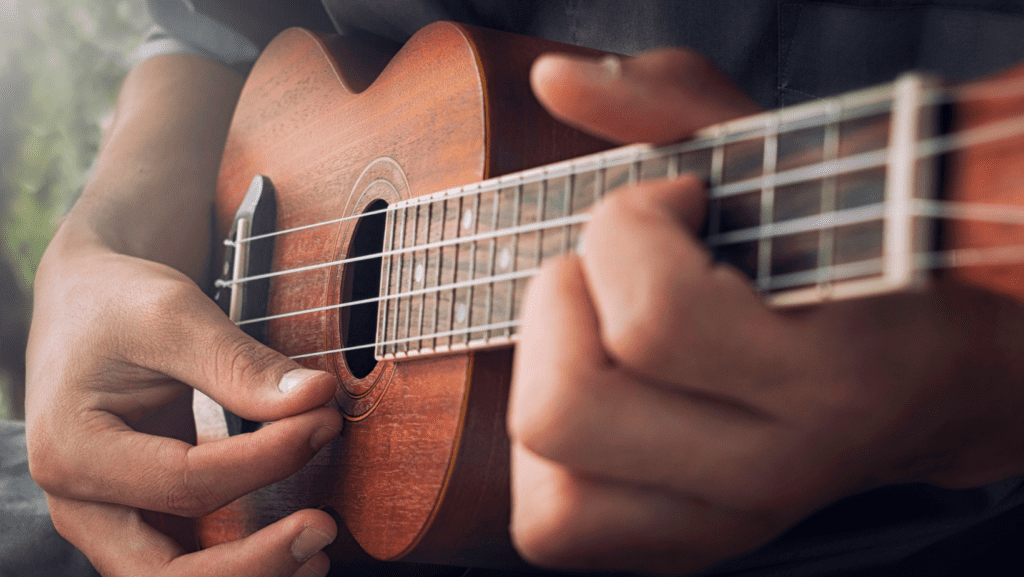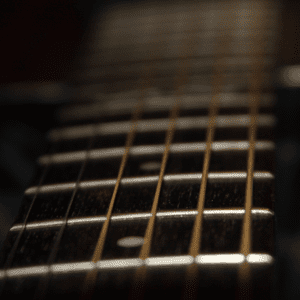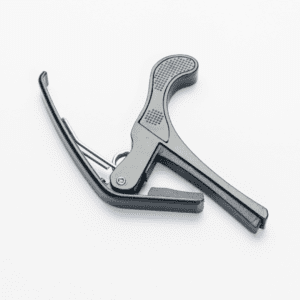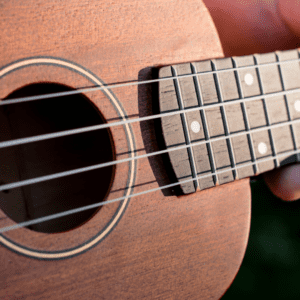
The past 15 years or so have seen a spark of interest globally in the ukulele. Its small stature, bright and sprightly tone has captured the hearts and minds of many aspiring musicians across the globe. Perhaps this is because of its small and unintimidating frame. That it’s less off-putting than bigger, more imposing instruments?
Whatever the reason for the popularity of this little string instrument, more people are using it as a gateway into the wider world of music. The ukulele is an easy instrument to learn that’s suitable for kids and grownups alike. It’s light and portable, making it easy to take with you when you’re on the move. The ukulele’s sound is light and happy and has captured the hearts of many around the world.
If you’re one of these people who’s recently come under the spell of the humble ukulele, and has recently acquired one, you may be wondering how to start learning.
If this sounds like you, then read on for more tips on how to begin learning the ukulele!
How Long Does It Take To Progress With The Ukulele?
There’s no real easy way to answer this question. How you progress will depend on many factors, including your previous musical experience, if any. With regular practice, you should be able to progress leaps and bounds in a short space of time.
Part of the appeal of the ukulele is how easy it is to learn. However, whether you have ‘learned,’ the ukulele or not will depend on your definition of what playing the ukulele is. If your goal is to strum a few chords and sing with friends, then you could be up to this level in a matter of weeks. As you progress and learn more complex strumming techniques and fingerstyle playing, you could easily play the same songs in a radically different fashion after a few years.
Here’s one YouTuber’s progress over 6 months.
Yet, this is all dependent on how much time, energy, and dedication you’re willing to put into learning. If you want to learn the ukulele and develop your own playing style, like any art form, it requires time and study. We can refer to these two differences as studying the ukulele and playing the ukulele.
Whilst they may seem similar from the outside, the difference is in approach. Studying involves a rigorous and systematic learning approach spread out over years. Playing is all about having fun.
Since many people are attracted to the ukulele for its simplicity and unintimidating appearance and character, we’ll focus on the second definition here. It’s not to say that you can’t study the ukulele, it’s that few people go down this route. People often opt for the ukulele’s bigger-bodied, more stringed cousins for serious study.
How Good Do You Want To Get?
It’s helpful to define what ‘playing,’ or ‘learning’ the ukulele means to you. `What inspired you to pick up the instrument in the first place? Are you inspired by a player with a particular strumming style? One who uses complex chord voicings? A fingerstyle player? A lead player? Or someone who plays simple chords to accompany themselves or others singing?
Once you know what you’re aiming for, you can take the necessary steps to achieve your goals. This way you can best set yourself up for success and avoid disappointment moving forward. Let’s take a look at what are the various techniques you need in different styles of ukulele playing.
How To Learn The Basics Of The Ukulele?
1. Chords
Chords are the basic framework through which you’ll structure your playing. For the overwhelming majority of people, learning a few simple strumming techniques and chord shapes will be enough for them.
Get a ukulele chord chart until you’ve memorized all the basic chords. It’s a handy thing to refer to and will end up saving you lots of time moving back and forward to websites or the back of a songbook. These are little things that sometimes take the enjoyment out of playing if you’re not careful.
Having an arsenal of basic chords up your sleeve is an important place to focus your attention when first beginning. Concentrate on the simplest voicings of each chord before learning other variations.
Once you know a few basic chords, you’ll be surprised at how many songs you can start learning. It’s shocking how simple many popular songs are once you analyze them musically.
For instance, see 22 songs with 4 chords.
Beginners, especially children, may find it hard to fret the strings hard enough to get a clear tone. This is normal, and in no time you’ll find your fingers will develop the necessary strength. This will come much quicker than on instruments such as the guitar (especially steel-stringed acoustics) as the string tension is much lower on the ukulele. Nylon is also much easier on the fingers than steel is.
It’s common to have difficulty in changing chords fast enough. If this is you, don’t worry, this is completely normal! It’s about generating the necessary muscle memory. Using a metronome will help make sure you’re changing in time, even if you’re not ready to play along with your favorite songs yet.
2. Barre Chords
Once you’ve mastered some of the most used chords for the ukulele, you can start learning some barre chords. Barre chords are when you cover one fret with your index finger, and then use the same chords shapes to produce different chords. Once you move the barre up a fret (lower down the ukulele) you’ll be raising the chord by a semitone.
Barre chords are useful for getting different voicings of chords at different positions of the neck of the ukulele.
3. Strumming Techniques
Once you’ve nailed some of the basic chord shapes on the ukulele, you’ll need to figure out how to strum them! Strumming on the ukulele provides the basic rhythm of your playing. There are innumerable ways of strumming, and each player has the potential to develop their unique strumming style.
Start with the most basic strumming patterns, making sure you’re changing chords in a clean and smooth way, in time with the music.
Once you get more advanced in your playing, you can start incorporating percussive elements into your strumming style.
After you’ve discovered the basics of strumming and some simple chords you’re ready for your first song! Learning songs is the whole aim of learning the ukulele in the first place (for most people.) Learning the basic techniques such as simple chords and simple strumming is often best done through learning a simple yet beautiful song.
Somewhere Over The Rainbow, by Israel “IZ” Kamakawiwoʻole is a ukulele classic.
You could even learn this on your very first day picking up the ukulele!
4. Fingerstyle
Fingerstyle playing is when, instead of strumming the chords, you pluck every single note by itself. You could also pluck more than one note, but as the ukulele only has four strings, we won’t worry about this too much.
Fingerstyle playing will most likely cause a lot more difficulty with people than strumming. If you’ve never done anything that requires articulation of your individual digits you might find the fingerstyle challenging. The ring finger will likely be weak and unwilling to follow your new demands that it moves on its own.
But, with regular practice, your fingers will strengthen and gain the independence they need for fingerpicking.
Frequently Asked Questions
Is The Ukulele Easier To Learn Than The Guitar?
As the ukulele only has four strings it’s easier to learn than the guitar. The small size makes it suited to smaller hands and the nylon strings used are easier to fret than steel strings of an acoustic or electric guitar.
The ukulele is a good ‘gateway drug,’ into the world of stringed musical instruments. If you’re unsure which is for you, try both! Whilst both instruments will take a lifetime to master, the ukulele will give you many transferable skills to use on the guitar, or any other string instrument.
How To Hold A Ukulele?
The most important thing is that you’re comfortable with no tension in your arms, shoulders, wrists, or fingers. Holding too much tension will likely lead to injuries down the line. Needless to say, this can leave you disheartened and unwilling to play and improve. You hold the body of the ukulele against your own, regardless of the hand you choose to fret the strings with.
As the majority of people are right-handed, many find it natural to fret the strings with your left hand, leaving the right hand for strumming. However, it is also possible to reverse this and fret the strings with your right hand and strum with your left, if this is more comfortable for you.
How To Spell Ukulele?
Ukulele comes from the Hawaiin words ‘uku,’ meaning flea, and ‘lele,’ meaning jumping. Because of this the Hawaiian original spelling of ‘ukulele,’ can be considered more ‘authentic,’ than the modern spelling of ‘ukelele.’
Both ways of spelling are considered correct, with ukelele being listed in the dictionary as an acceptable alternative spelling.
What Are The Different Types Of Ukulele?
The different types of ukulele are, in ascending order of size; soprano, concert, tenor, and baritone. Soprano is the most popular choice for beginners. As you advance into your study of ukulele, you may find yourself moving from the soprano ukulele to any of the bigger models at some point. The concert, tenor, and baritone ukulele being bigger offer the player more options in terms of notes and chord voicing options.
What Kind Of Strings Does A Ukulele Use?
Ukuleles use nylon strings. When buying ukulele strings make sure you buy the correct ones. Make sure you know what kind of ukulele you own (soprano,concert,tenor,baritone) and get the corresponding strings.
The strings you use will affect the type of tone you can get out of your ukulele. Old strings will leave your ukulele not sounding as clear and articulate as it could. Not changing your strings when you need to could leave you feeling uninspired, as your instrument won’t be looking and feeling its best.
How To Change The Strings Of The Ukulele?
Remove the old strings. Create a figure of 8 with an extra loop below the bridge with the new string, pass the other end of the string through, and pull this knot against the bridge. Pass the other end through the tuning peg, create a loop and pass the string through this loop. Tighten and tune!
Changing the strings of a ukulele is a simple procedure that, after a few times, becomes like second nature. Strings should be changed if you start to feel that the ukulele is sounding dull, lacking in life, and not as cheery as it’s meant to be.
How To Tune A Ukulele?
Standard ukulele tuning is GCEA, sometimes referred to as C tuning. This corresponds to G4, C4, E4, A4 on the piano, with the numbers referring to the octaves. If you have a keyboard/piano, C4 is middle C.
If you don’t have a piano or keyboard to hand, then the easiest way to tune your ukulele is with a tuner. Failing that you could also use one of the many instrument tuning apps available.
I’m Thinking Of Learning The Ukulele, What’s A Good Ukulele To Start Learning On?
As the name suggests, the soprano is the smallest ukulele, the most popular, and the cheapest. This is followed by the concert ukulele. A good starting ukulele should have everything you need to start your journey and feel like a musical instrument and not a toy.
It’s important to choose an instrument that will help you to grow as a musician for a period of time. Many cheap, beginner instruments are unsuitable to see you grow as a musician beyond the very first steps of learning.
Practice Tips For Beginners
Be Consistent!
As with any skill, consistency is the most important thing. It’s better to practice for 30 minutes a day, every day than doing all your practicing over one or two days. This allows both your body and mind to better absorb the new information and form new neural pathways from your study.
When you’re starting with the ukulele, especially if you’ve never played a string instrument before, your fingers will take time to build up the strength and dexterity required to play.
Consistency with practicing will help ensure that you can reinforce the new techniques you’re learning, and embed them within your skillset so you can own them.
Go Slow!
Focus on learning a select few things at a time, especially at the beginning. This can help keep your morale up, by helping you to see real progress in your playing. This can help keep you motivated and excited to learn more and ensure you that you are on the right path.
Trying to take on too much at the beginning of any endeavor can leave you feeling overwhelmed and like the path ahead is long, arduous, and unending. Focusing on the key techniques of the main chord shapes, strumming, and fingerpicking at the beginning can ensure you build strong foundations into which to take your study of the ukulele going forward.
Have Reasonable Expectations
You can’t expect to go from zero to this overnight:
Having reasonable expectations of yourself is key for keeping your morale up. Knowing where your weaknesses are as a player is a good way to ensure your growth as a musician, provided, of course, that you work on these weaknesses.
Recording yourself on your phone or a microphone is a good way to hear what you sound like. Listening to yourself whilst you’re playing doesn’t give you a good impression of what you actually sound like. It’s easy to think we sound good when in actual fact, we don’t.
Use A Metronome
Using a metronome will help ensure you’re playing in time, and not racing ahead or slowing down at certain points. This is an important skill to stress, especially if you plan on playing with other musicians somewhere down the line, or even if you’d like to record yourself.
Timing and rhythm are an important part of music, and using a metronome can help embed timing into your brain so it becomes like second nature to you. Playing in time is a skill many solo musicians fail to develop, and playing to a metronome from the beginning can help you get used to this from the get-go.
To Sum Up
Learning the ukulele can be a fun and rewarding experience, to say the least. How you manage to progress will depend on any musical experience you have beforehand. Someone with prior musical skills and experience will likely progress much faster than a complete beginner will.
Someone who already has experience with string instruments will likely progress much quicker than someone who has none, for example. Skills such as a good ear, a sense of rhythm, and knowledge of music theory are transferable throughout any musical discipline. Once you have these skills, it’ll make any further musical learning that little bit easier.
So to answer the question of how long it takes to learn the ukulele, it depends. You could conceivably go from zero to being able to strum many simple four-chord songs in a matter of an afternoon.
Like with anything, however, if you want to master the ukulele, to study it, well that’ll take you a lifetime.





